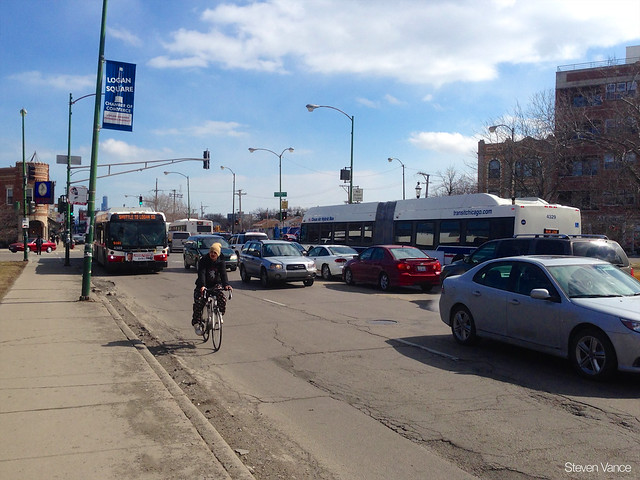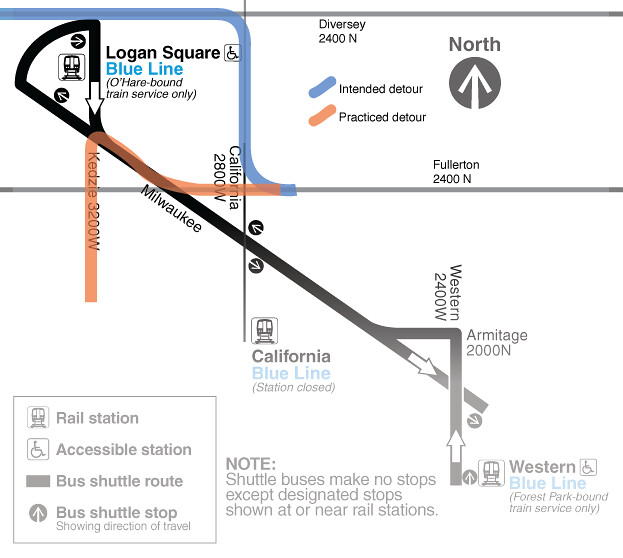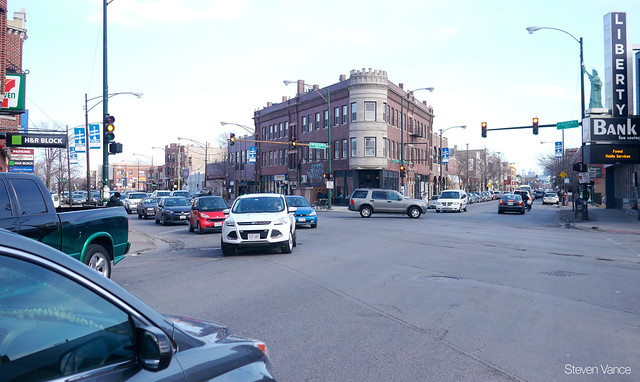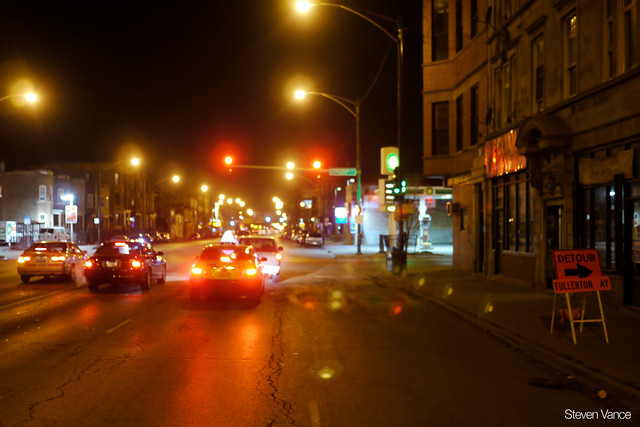
Last weekend's Blue Line track work, just one week of the months-long Your New Blue project, pushed rail riders onto shuttle buses that ran along Milwaukee Avenue -- and right through a traffic jam created by the very same track work. Instead of following the designated detour, drivers diverted from Fullerton and Sacramento Avenues under the Blue Line piled onto Milwaukee Avenue and slowed buses to a crawl.
An alternative approach that I'd suggested earlier would have set up diverters on Milwaukee, preventing through traffic while still allowing access to all businesses and parking spaces. Since there were no diverters to keep Fullerton drivers off Milwaukee, many drivers continued on Fullerton and then -- at the last minute -- turned onto northwest-bound Milwaukee, adding more traffic to a stretch that's already plenty busy during weekends. The resulting traffic jam paralyzed not only the Blue Line shuttle buses, but also the heavily used 74-Fullerton and 56-Milwaukee bus routes.

A small sign on Fullerton directed drivers to turn onto California, but the road ahead was wide open, and barriers didn't force a turn off Fullerton until Milwaukee. Forcing a turn at California would have kept Milwaukee relatively clear for the many shuttle buses needed to carry Blue Line passengers, minimizing their delay and keeping the "rapid transit" service at least a little bit "rapid."
Gareth Newfield, a longtime Logan Square resident I interviewed while we both watched crawling, bunched-up shuttle buses from inside the Logan Square Comfort Station, noted that "the CTA always provides complete service" during construction projects, "but it doesn’t provide good service."
Newfield suggested shifting priorities. "How about we say, 'Getting people to the airport is such a priority that we'll shut down a [traffic] lane to run express buses' " and maintain adequate service for Blue Line riders traveling through Logan Square. "The city isn't taking [that trip] seriously, but the CTA does." Newfield added that the few personnel dispatched to a site aren't thinking about traffic jams as a system: "even a cop… isn't thinking about it – 'hold on folks, this bus needs to go first' -- or limit[ing] turns."

Even where there were additional lanes, for example through the square, no space was dedicated for transit; instead, both lanes were filled with cars. The CTA didn't respond by press time to a request about shuttle bus speed data.
@streetsblogCHI @DanielKayHertz @transitized @tracyswartz total mess on Milwaukee. Shuttles took 20-30 minutes to travel through corridor.
— Transport Nexus (@transportnexus) March 24, 2014
He later tweeted that "[I] probably could have walked faster."
Police officers or Traffic Management Aides were not on scene to change or hold traffic signals, or to prevent turns onto Milwaukee when they saw a shuttle bus coming.
Erin Borreson was biking northwest on Milwaukee to the Comfort Station; she had to get off her bike and walk on the sidewalk because there was too much traffic. "Buses were [driving] so close to the parked cars," she explained, "and there's no way a biker could have gotten through." Borreson said she was not only more comfortable on the sidewalk than in the jammed street, but added "I was faster on the sidewalk."
The next Blue Line bus bridge along an equally congested stretch of Milwaukee will start Friday, April 4, replacing Blue Line service at Damen and Western. The shuttles will run a much longer route than the first weekend -- from Western Avenue to the Clark/Lake station -- because it's the only way to provide fully accessible service.
The same problems may recur that weekend, unless there are appropriately enforced detours. Whenever there are more buses on the road, that means more traffic. The city has a lot of options at its disposal to live up to the spirit of its Complete Streets policy, and to put transit riders first.





